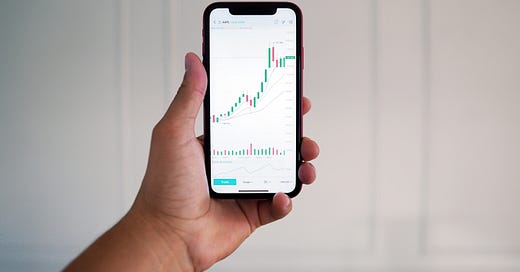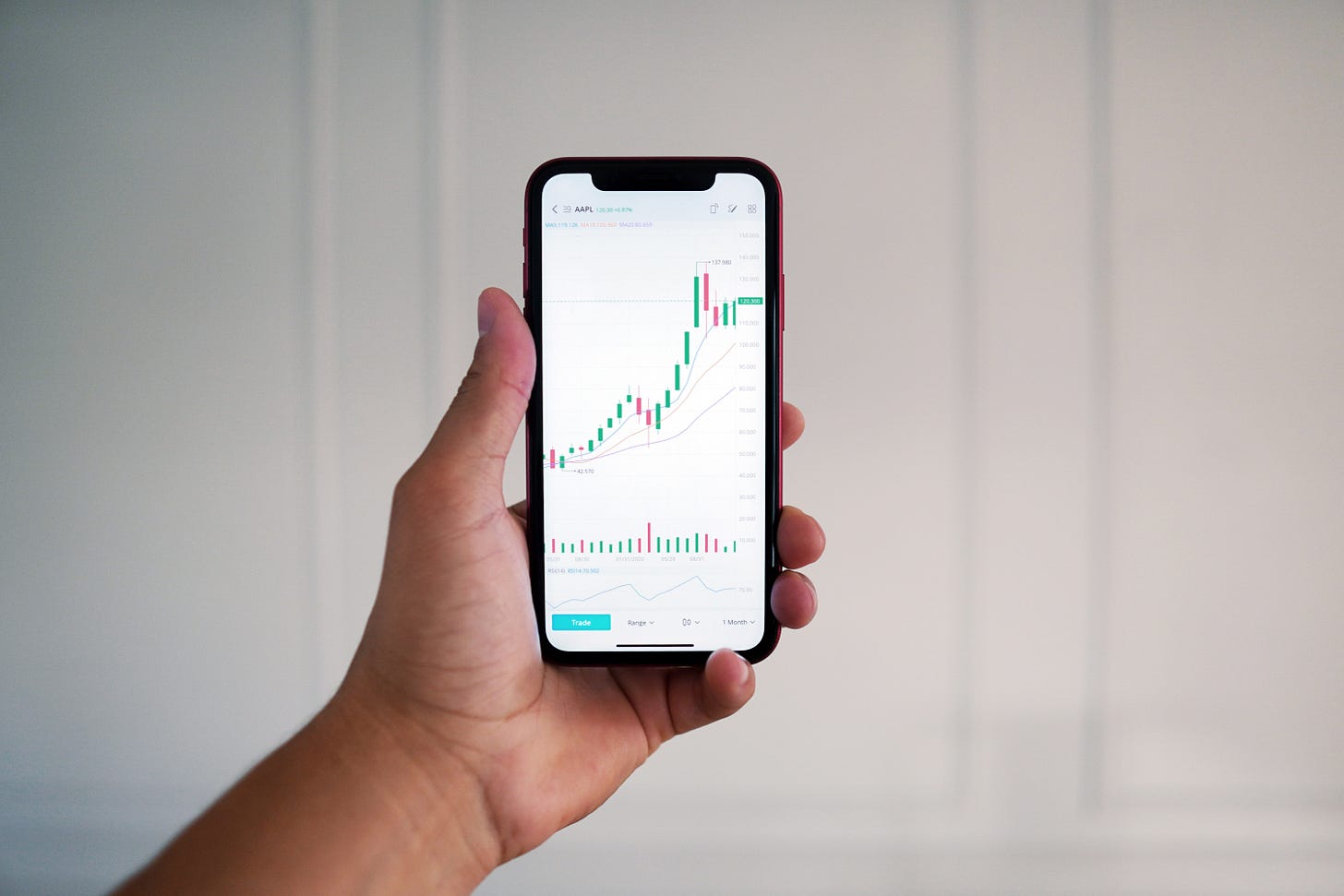Step up your investing game in 2022
Practical guide to become a more strategic investor. Stock picks not included.
None of this information is financial advice or recommendation.
Whether you are a passive investor or a pretty active trader, new year is a great opportunity to take a step back, look at your investment portfolio holistically, and course-correct if needed. While I wish I had an oracle to tell you what investments to make, I hope this article will give you a useful and easy-to-follow framework to be a more intentional and strategic investor in 2022:
Transparency ➡️ insights ➡️ improvements. Let’s go!
📸 Step 1: Get the full picture of your portfolio
Before we can optimize our portfolios, we have to understand what we’re dealing with. Most people don’t have a good view of their investments and I can’t blame them. Our money is spread across multiple accounts sitting in multiple institutions, which makes it hard to see the full picture.
Below is a short cheat sheet to help you remember where your investments might be seated. If you have a spouse, you should consider running this review together.
🕵️ Where is all my money?
Top 10 suspects:
Retirement accounts (401k, Roth IRA, IRA …)
Traditional brokerages (Fidelity, Schwab, Vanguard, E-Trade …)
Robo-advisors (Wealthfront, Betterment, Marcus …)
Bank accounts (Checking, saving, and high yield saving accounts)
Trading apps (Robinhood, M1, Stash, Acorns …)
Crypto exchanges (Coinbase, Binance, Kraken ..)
Crypto wallets (Metamask …)
Health Savings Accounts (HealthEquity …)
College Savings Accounts (529, ESA …)
Peer-to-peer payment apps (PayPal, Venmo ..)
Once you are done reviewing all your accounts, you might be tempted to write everything in a spreadsheet. While this is a solid first step, there are a few obvious problems: a spreadsheet won’t update automatically and, unless you’re a spreadsheet wizard, you won’t be able to slice and dice your portfolio by other metrics such as asset class or holding. Such views can give you additional insight and help you optimize allocations. More on that later in the article.
At this point I would love to toss in a quick plug for AssetClass since I genuinely believe we can make this exercise much easier. AssetClass allows you to securely connect all your accounts in one place. AssetClass then automatically fetches your holdings and tracks your balances over time. While the initial setup might take a few minutes, it’s once and done, allowing you to see all your accounts, get tips and insights, and manage your investments more seamlessly than ever before.
🧐 Step 2: Ask probing questions
Once you know where all your money is and have a holistic view, you can start asking more questions about your portfolio. We’ll start with a few here and although they sound pretty simple on the surface, there are often more complexities as you dig a level deeper.
💰 2.1 What is the total value of my portfolio?
You can think of your portfolio value as being subdivided into two asset types, liquid assets and illiquid assets.
Liquid assets are assets that can be readily converted to cash, which also means they are relatively easy to price. Liquid assets are what most retail investors track and think of when they talk about their investment portfolio (cash, securities, crypto). It’s also the main focus of this article.
However, many people also hold significant illiquid investments such as real estate or angel investments. Valuation of these assets is trickier as it often requires a bit more research and use of one’s own judgment. It’s good to run an annual review of all your illiquid assets, note their approximate values, and have a sense of their share in your total portfolio.
📊 2.2 How is my portfolio allocated?
An asset class is a group of investments with similar characteristics. Cash, Equities (stocks, ETFs) and Bonds have historically been the major asset classes, with everything else being lumped into the “Alternatives'' category. However, some alternatives have become so prevalent that they are also commonly referred to as asset classes: Crypto, Derivatives (options), and Commodities (gold etc.) are some common examples.
Regardless of the taxonomy, it’s good to understand your percentage allocation among the main asset classes –i.e. what portion of your total assets are in each category – and reflect on whether you’re comfortable with that allocation.
This exercise is so useful because you might realize that you’re over or under-exposed to a certain asset class or even a single stock! For example, it’s common for tech employees to hold 30% or more of their portfolio in their company’s stock.
Often, people realize they have too much free cash lying around across various accounts and decide to consolidate. You don’t need to have investments in every asset class, but it’s helpful to understand what all the main options are and know why you may or may not want to be allocated in one. Here’s my current allocation:
📈 2.3 How is my portfolio really performing?
It’s very important to distinguish the growth in your balance coming from the continued deposits, from the change in value of your underlying assets. Counterintuitively, the better you are at investing continuously (dollar-cost averaging), the more deceiving the whole situation can be. If your bottom line continues to grow (let’s say because you invest $100 out of every paycheck), it may seem like you’re performing well, but the assets you’re buying with your $100 may not be growing at the same rate as the market. Many modern finance apps really don’t offer full transparency as they focus on total balances only.
Bringing clarity to investment performance is one of the top priorities for us at AssetClass in 2022. For now, I recommend looking at investment returns of your top holdings and compare them to each other using Google Finance. Below is an example for 3 of my holdings: VTI (Vanguard Total Stock Market Index), Tesla, and Bitcoin. It’s interesting to see them next to each other not just in terms of 2021 YTD returns but also in terms of volatility - even Tesla seems pretty stable compared to Bitcoin.
A related exercise is to compare performance between your accounts or main asset classes: Is your play fund in Robinhood beating the market? Is your crypto portfolio beating your stock portfolio?
While we all have heard the investing mantra of “past performance isn’t an indication of future results,” far too often we tolerate underperforming assets in our portfolio. We either hope the tides will eventually turn, or worse, losing assets slip under our radar and we’re not even aware we’re losing money!
💪 Step 3: Reflect and act
There is no one right answer for what your portfolio should look like. The traditional methodology that most financial advisors and robo-advisors use is to understand one’s risk appetite and allocate accordingly among bonds and stocks. Many self-directed investors don’t follow this model and prefer to allocate their capital based on other methodologies such as theme-based investing or other investment philosophies. In fact, we run a whole blog devoted to this topic!
As a general rule of thumb, the more you expect to need cash in the near future (e.g. for a downpayment on a house, for retirement, or to pay for your sabbatical trip), the more of your investments should be in stable assets. I recommend looking at your portfolio and reviewing whether it’s aligned with your goals at least once a year.
Hopefully, the exercises above inspired you to think holistically of your allocations and performance. If that feels too overwhelming, you can start by even simpler questions / reflection on the past year:
🧘 Investor reflection prompts
Am I comfortable with my assets fragmented across accounts, or should I consolidate?
Are my investments aligned with my values (sustainability, environment etc)?
Have I maximized my contributions into tax-advantaged accounts?
Have I taken advantage of tax loss harvesting?
Have I sold out of panic or invested out of impulse? What did I learn from that?
We will not go deeper into these topics now but let us know if you want us to cover them in the future.
In conclusion, the most important thing is to see the full picture and be intentional in aligning your investment strategy with your life stage and goals.
Katka is a co-founder of AssetClass, a platform for retail investors to track all their existing accounts, and get unique and holistic insights.






